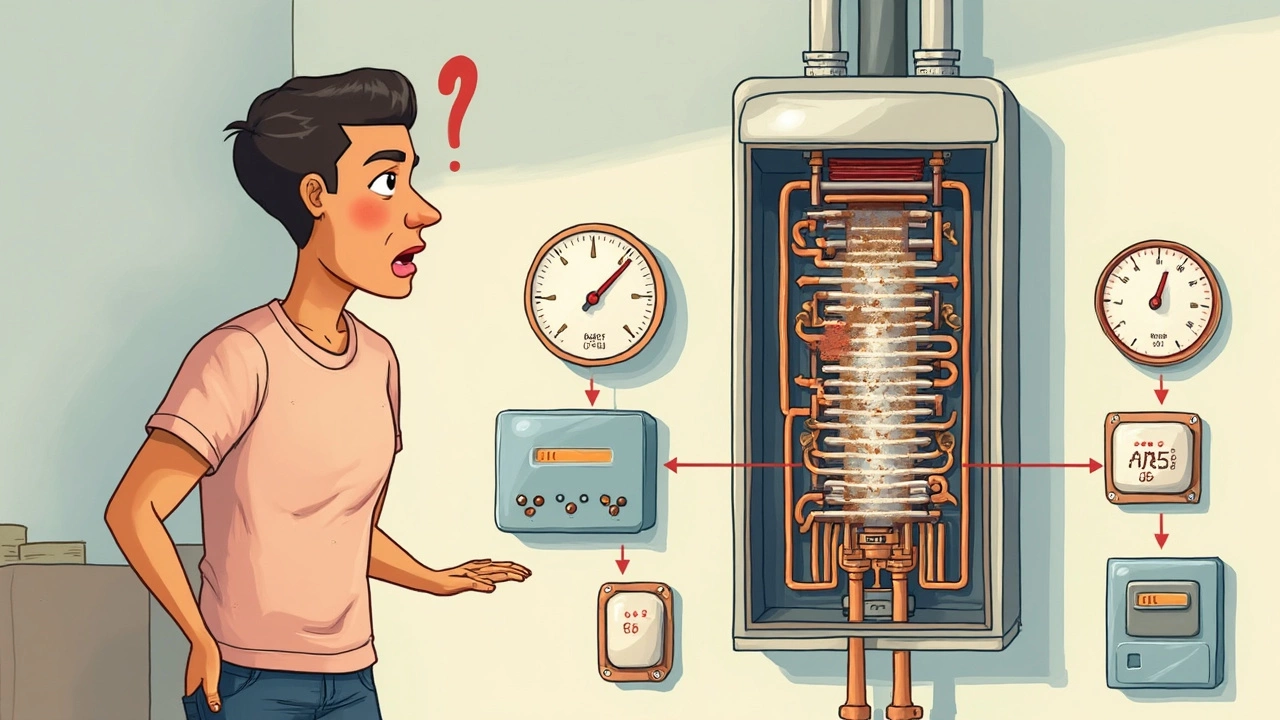Ever had that shockingly cold shower moment when you expected warmth? Sounds like you might have a hot water heater issue on your hands. One of the usual culprits is a bad heater element. It's that part of your water heater responsible for heating the water. I know, the last thing you want is to mess around with appliance repair, but hang tight—this guide's got your back.
First things first, all water heaters use one or more heater elements to warm the water. If one goes bad, it can affect how much hot water you get or, in some cases, eliminate it altogether. You might notice lukewarm or downright cold water coming out of your taps, even when you've got the dial turned full blast. Before you dive into testing or replacements, it's key to recognize the warning signs.
- Understanding the Role of a Heater Element
- Signs Your Water Heater Element Might Be Failing
- How to Test a Hot Water Heater Element
- When to Replace a Heater Element
- Preventing Future Water Heater Issues
Understanding the Role of a Heater Element
Alright, let's break down what this heater element thing actually does. Picture it as the heart of your hot water heater. It’s the piece of technology that converts electrical energy into heat to warm up the water in your tank. Different heaters might have one or two elements depending on their size and design, and each is plugged in at different spots within the tank.
Your average water heater element is a metal tube, and it's submerged in the water inside the tank. When you turn on your hot water tap, cold water enters the tank, and the element kicks into gear, quickly heating up to bring the temperature to whatever setting you've programmed. If one of these elements craps out, you’re left with lukewarm showers or worse, no heat at all.
These elements come in different forms—like screw-in or bolt-in types—and can be made of various materials such as copper, stainless steel, or even nickel. Each material has its pros and cons regarding longevity and performance, but they all serve the same basic purpose: turning cold water into hot.
The elements usually power on and off automatically to maintain the tank’s set temperature, which can range from about 120 to 140 degrees Fahrenheit in most homes. Say your showers are acting up? One of these elements might have gone kaput, and knowing which kind you've got is the first step in swapping out the bad for the good.
If you're a stat-lover, get a load of this: A standard 50-gallon hot water heater with two elements typically uses around 4500 watts per element. Knowing this can help you figure out if there’s an energy consumption spike when your bill arrives.
Signs Your Water Heater Element Might Be Failing
Nobody enjoys an unexpected cold shower, right? If your hot water is suddenly not so hot, it could be a sign that your hot water heater element is giving up. These elements can fail over time, and here are the telltale signs it's happening.
First off, inconsistent water temperatures are a big red flag. If you set your shower to your usual warm setting and it feels like popping soda from the fridge, the element might be on its way out.
Another clue is the water not staying hot as long as it used to. If your morning showers start cozy but quickly turn icy, that means your heater isn't keeping up, possibly due to a faulty element.
Ever heard strange noises from your water heater? A buzzing or humming sound can mean the element is struggling. It's like your heater's trying to tell you something's up.
Increased energy bills can be another wake-up call. A broken heater element often means your system is using more power than usual to try and heat the water.
"Keeping an eye on your heater's performance is crucial," says James Montague, a leading technician at Home Appliance Experts. "These warning signs are your first cue to prevent a bigger hassle down the line."
- Inconsistent temperatures: Your showers switch from warm to lukewarm in a flash.
- Short-lived hot water: It feels like your hot water lasts less and less with each use.
- Strange noises: Buzzing or humming can be more than just annoying; it's a sign.
- High energy costs: Watch out for sudden spikes in your utility bills.
If you're noticing a pattern here, your next step should be testing the heater element or calling in the pros to diagnose and fix the problem. Ignoring the signs could lead to bigger headaches down the road, like those dreaded cold showers every morning!

How to Test a Hot Water Heater Element
So you've decided to take matters into your own hands and test your hot water heater. Good call, because knowing if your heater element is the problem can save both time and cash. Let's walk through the steps to figure this out.
Before we get into it, safety first! Always make sure the power's turned off at the circuit breaker—electricity and water aren't the best mix.
- Gather Your Tools: You'll need a multimeter, a screwdriver, and for extra peace of mind, some safety gloves. Got them? Great!
- Access the Elements: Remove the access panel on the water heater. Usually, these panels are at the side, and you'll need that screwdriver to get them off. Inside, you might find some insulation or a plastic cover, so take those out gently.
- Check the Power: Double-check with your multimeter if there's any electrical current before getting your hands near the element—better safe than sorry!
- Disconnect the Wires: The heating element usually has two wires connected to it. Carefully disconnect these so you can test the element itself.
- Test with the Multimeter: Turn your multimeter to the lowest ohms setting. Place each probe on the screws of the element. If the reading is between 10-16 ohms, your element is likely fine. Higher or lower, though, means it's time for a new element.
Testing your hot water heater might seem tricky, but once you get the hang of it, it's all straightforward. Here's a little tidbit:
| Element Status | Resistance Reading (Ohms) |
|---|---|
| Good Element | 10-16 |
| Bad Element | 0 or very high |
If your test indicates a bad element, replacing it isn't too tough, but you might want to call in a professional if you're not comfy with doing it yourself. Better safe than scalded—or unscalded!
When to Replace a Heater Element
So, you’ve figured out your hot water is acting up and suspect the heater element might be the issue. But how do you know it's time for a replacement? It’s easier than you think to determine. Let’s break down the signs that scream it’s time for a new one.
One classic symptom is inconsistent water temperatures. If you’re getting hot water one minute and then chilly surprises the next, it’s not just the universe playing tricks on you—it’s likely a problem with the water heater element. Another giveaway? No hot water at all. If your heater isn’t heating, the element is often the first place to look.
You might also hear strange noises coming from the tank. Ever heard a water heater rumble or hiss? Sediment buildup can cause the element to overheat and make noise. If flushing doesn’t solve it, time to swap out that element!
Want to dig even deeper to confirm? You can test the element using a multimeter. It’s a useful little tool to check if the element has continuity—essentially if the current can flow through it. No continuity means no work, and it’s replacement time.
- Turn off the power to your water heater first. Safety first, always!
- Remove the access panel on the heater and use the multimeter on the element’s terminals.
- If it reads zero or infinite resistance, the element is shot.
Don’t think twice if your heater is over its prime age of 6-12 years. If the element is causing frequent trouble, it’s smarter and more cost-effective to replace it rather than constantly repair.
And hey, keep an eye on your utility bills. A failed element often makes the heater work overtime, which cranks up your energy costs without better results. So, check the signs, make your call, and say goodbye to those unwanted chilly showers!

Preventing Future Water Heater Issues
Let's talk prevention, because who doesn't want to avoid scrambling for a fix in the middle of a morning shower rush? Keeping your hot water heater in tip-top shape is a whole lot easier when you have a few tricks up your sleeve.
First, regular maintenance checks are key. Consider making it a bi-annual job. This includes inspecting the heater element and controls for any signs of wear and tear. Sediment build-up is another bad guy here, especially in places with hard water. Think of it like plaque for your heater; over time, it can mess things up.
To combat this, drain your tank at least once a year to flush out sediment. It's straightforward: turn off the heater, attach a garden hose to the drain valve, and let it flow till it runs clear. Not too tough, right?
Keep an eye on temperature settings too. It's tempting to crank up the heat, but setting it around 120°F (49°C) is often sufficient. It keeps energy bills down and prevents the heater from working overtime—saving the water heater element from potential burnout.
Here's a handy tip: install a water softener for homes with notoriously hard water. It can help reduce the sediment, keeping your heater happier for longer.
Lastly, trust your gut. Weird noises, inconsistent heating, or anything out of the norm? Don’t brush it off. A little attention now can save you from bigger headaches—like icy showers—later on.
Sound like a plan? Keep these tips in mind, and you'll be ahead of the game, keeping those cold surprises at bay!

